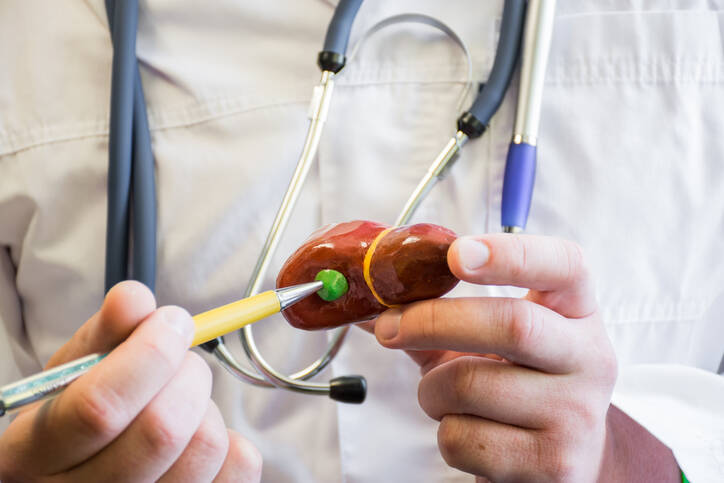- akv.sk - Clinical Nutrition - Gallstones
- nemocnicapp.sk - Cholecystectomy - surgical removal of gallbladder
Gallbladder and gallbladder pain: what are the most common causes and diseases?

The gallbladder is an organ that has an important function in the process of digestion. When it malfunctions, it can cause a lot of trouble. Let's take a look together at its most common diseases.
Article content
The gallbladder (vesica biliaris or vesica fallea in Latin) is a hollow, pear-shaped organ located just below the liver, in the area of the right side of the abdomen below the ribs.
Its function is not to produce bile, as many think, but to store and thicken it. Bile is produced by the liver and flows into the gallbladder through the bile ducts.
Typical gallbladder pain is also known professionally as biliary colic. This name is derived from the Latin name for the gallbladder (vesica biliaris).
Bile is a thicker yellow-brown fluid that is involved in the digestion of fats. When needed, it is secreted from the gallbladder into the small intestine. This happens about 30 minutes after eating a meal.
The hormone cholecystokinin is responsible for this trigger mechanism. It commands the gallbladder to contract, thus releasing the bile into the small intestine. More precisely, into the first part of the small intestine, called the duodenum. There, the bile takes care of the proper digestion of fats.
Bile is made up of various substances, such as a mixture of bile acids, bile dyes, cholesterol, proteins, salts, fatty acids and so on.
Its yellow-brown coloration is due to a yellow dye called bilirubin. It is actually a waste product of the metabolism of red blood dye, which is produced by the liver from defunct red blood cells.
Are you experiencing non-specific pain in your left or right side?
The most common gallbladder problems
Disorders of the gallbladder and its function are mainly manifested by pain and indigestion. In some cases, its surgical removal is necessary.
Since the gallbladder is not essential for life, it is possible to live without it. However, this requires certain restrictions and principles.
In this case, the bile does not accumulate in the gallbladder, but drains from the liver directly into the duodenum. When the intake of fatty food is increased, bile is deficient and the fats are only partially digested. They are only broken down in the colon. This is often accompanied by flatulence, bloating or even diarrhoea.
Without a gallbladder, digestive problems occur especially after eating larger amounts of fatty food, for which more bile is needed.
If you have pain in your right side or non-specific digestive problems, you may also be suffering from this organ. Let's take a look at the most common gallbladder diseases together.
Gallbladder stones - cholelithiasis
The technical name cholecystolithiasis is the name given to the formation of concretions (stones) in the gallbladder. Choledocholithiasis is the name given to the presence of stones in the bile ducts.
Gallbladder stones are formed by precipitation of bile constituents such as calcium salts, bilirubin or cholesterol. The cause is also usually due to impaired or slowed bile outflow.
Risk factors for gallbladder stone formation include:
- a diet high in cholesterol and unsaturated fatty acids
- age over 40 years
- obesity
- pregnancy
- certain diseases
- skipping breakfast
- fat metabolism disorder
These stones can obstruct the bile ducts, which will manifest as severe throbbing pain in the area below the right rib arch. They often radiate to the back or abdominal area.
They are also described as a gallbladder attack or biliary colic. It is caused by the gallbladder and bile ducts working to expel bile and overcome an obstruction in the bile ducts.
These pains come especially after ingestion of fatty food when bile is secreted in large quantities. Such an attack can last for several days. Then do not hesitate to seek professional help.
Treatment in this acute condition consists mainly of soothing the gallbladder and relieving the pain. Patients are given medication to relax the gallbladder musculature. Dietary measures must be followed. Only later may gallbladder surgery be considered.
The so-called laparoscopic surgery is the most preferred. It is a minor procedure that requires a shorter recovery time. It is less burdensome for the patient and the operating team. Instead of a conventional surgical wound, usually only 4 small incisions are made. Through these incisions, special surgical instruments are guided to perform the operation.
Inflammation of the gallbladder - cholecystitis
Inflammatory gallbladder disease can have several causes, but up to 90% are related to gallstones.
Inflammation is the body's response to certain damage. It is caused by the action of immune cells and substances released from the affected tissue. It can also be triggered by certain micro-organisms.
In gallbladder inflammation, we distinguish between acute and chronic forms. Acute (sudden) is manifested by rapidly arising pain in the area below the right rib arch. It is often accompanied by fever. The pain increases with movement or inspiration. It usually lasts for several days.
The chronic course is prolonged and unremarkable. Patients describe only non-specific symptoms such as mild pressure in the right flank or indigestion or nausea.
Another division of gallbladder inflammation is based on the presence of gallstones. In most cases of gallbladder inflammation, stones are present. These can easily move into the bile duct and cause bile accumulation, gallbladder colic and other complications associated with the disease.
In addition to gallbladder stones and bile outflow disorders, bacteria that cause inflammation can easily enter the gallbladder from the duodenum.
10 % of gallbladder inflammation is not related to gallstones, but may be due to various poisonous substances or to conditions following trauma or surgery.
Gallbladder inflammation, especially when untreated, can lead to various complications. Inflammation can spread to surrounding tissues or even form so-called adhesions. This is an abnormal connection between the gallbladder and surrounding tissues or organs, which results from inflammatory processes.
A serious complication of extensive inflammation of the gallbladder is the rupture of the gallbladder wall and spillage of its contents. The consequence is sudden and extensive inflammation, which must be treated acutely, as it is life-threatening.
The treatment consists of rest, fasting and painkillers. Over time, the gallbladder diet is switched to a fat-restricted diet. In more serious cases, surgery, i.e. surgical removal of the gallbladder, is resorted to.
Gallbladder cancer
Carcinoma of the gallbladder is a relatively common cancer of the digestive system. It is formed by cells that are part of the inner wall of the gallbladder. It often grows into the surrounding structures and disrupts them. In the later stages of the disease, the tumour spreads to the liver, intestine, pancreas and peritoneum.
Initial symptoms are subtle and non-specific. Patients may experience mild indigestion. Later, pain usually occurs in the right flank, below the ribs. Gallbladder inflammation may accompany the disease. Later, there is loss of appetite, vomiting, weight loss and jaundice.
Blood tests may show an accumulation of bile or an increase in bilirubin, a yellow dye.
Diagnosis is mainly based on imaging methods. These can reveal liver enlargement and the presence of masses.
Among the more accurate examination methods are imaging methods - CT or so-called ERCP. This is an examination in which a special tube with a camera is inserted through the patient's mouth to the bile ducts.
A contrast agent is also used, which subsequently shows the bile ducts or obstructions or various formations in the bile ducts on the X-ray image.
ERCP can also be used to take a tissue sample which is then examined under a microscope. This is known as a biopsy.
When the disease is detected early, surgical removal of the gallbladder and, if necessary, removal of the affected liver tissue or lymph nodes is often performed.
Treatment often includes radiation and chemotherapy. This depends, of course, on the individual condition. The prognosis, i.e. the likelihood of further disease development, depends mainly on early detection of the disease.
Read also our interesting article.
Interesting resources










